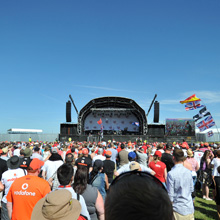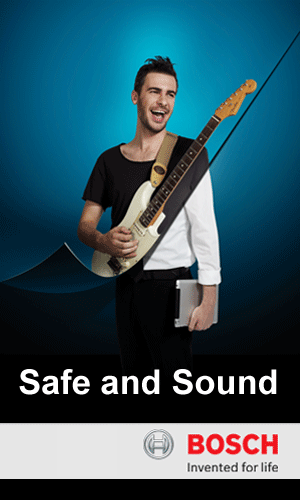 |
| Signals were amplified by TG7 and TG5 amplifiers from Electro-Voice equipped with RCM-26 remote control modules |
The end of June at Silverstone saw the running of the oldest race in the Formula One calendar: the British Grand Prix, which was witnessed by 120,000 fans at trackside and millions more on television. The race turned out to be dramatic, with Nico Rosberg taking the chequered flag at the end of the day. Nearby, on the large open-air stage, it was musical acts of the caliber of Billy Ocean that drew the cheers.
Since the organisers had been highly satisfied with the quality of the sound system the previous year, they saw no reason for a change, and once again in 2013 line-array systems from Electro-Voice hanging to the left and right of the stage provided the sound reinforcement, supported by further hangs on the two delay towers and additional cabinets serving as front fill. In all, 36 XLC and 24 XLE line-array elements with FIR Drive were deployed to ensure transparency and high sound pressure levels, with 24 Xsub units reinforcing the bass. The signals were amplified by TG7 and TG5 amplifiers from Electro-Voice equipped with RCM-26 remote control modules. As stage monitors providing fold back to the musicians, Electro-Voice XW15A wedges were used, while two DYNACORD X2A stacks powered by Xa 4000 system power amplifiers provided side fill. On stage, numerous microphones from Electro-Voice were also in evidence, including models like the RE20 and the RE320.
The responsibility for the infrastructure of the sound system was given to The Freeman Company. Freeman’s Group Project Director, Paul Goodall, commented “What was special about the sound at this year’s Silverstone was the fact that we used a Dante network and worked almost entirely on the digital plane. That saved us a great deal of work with the cabling, and therefore both time and money; moreover, use of the Dante network made the system unbelievably reliable, so that, during the event, not a single unit failed.”
The signals were converted to the digital plane by a stage box and routed to a NetMax N8000 digital matrix equipped with EV DM-1 modules. From there, they were fed into a Dante network from Audinate. “This year, the consoles at the front-of-house and monitor positions were both digital. We used NetMax, among other tasks, to switch between the mixing consoles of the individual acts. That allowed us to route the outputs of the consoles of the different bands directly to the PA and monitor systems without using a master console. Acoustically, too, that was an advantage, as instead of being converted backwards and forwards from analogue to digital several times, the signals remained on the digital plane, which made the midrange, for one thing, far clearer.”
The network, however, was not reserved for FOH and monitor signals but also served the VIP area and part of the intercom system, as Paul Goodall explains: “We also fed the signals from the talkback microphones assuring communication between the FOH and monitor positions into the network. This gave the production managers a far better overview of the proceedings, allowing them to discuss matters with the technicians and control the event more efficiently.”




